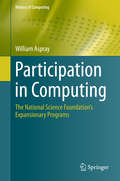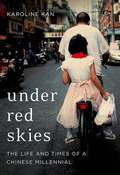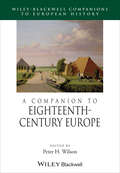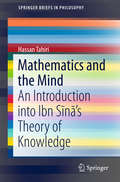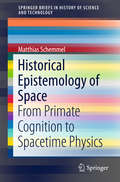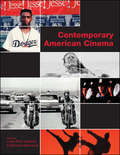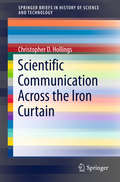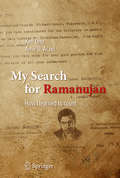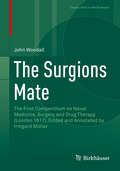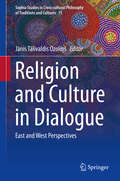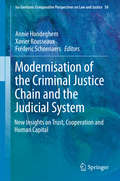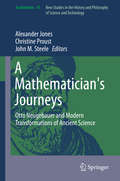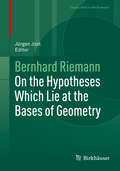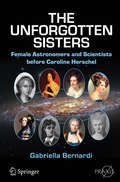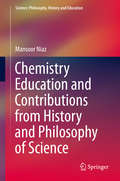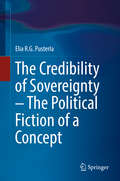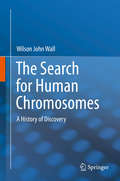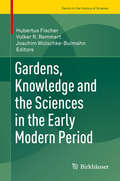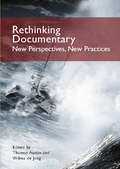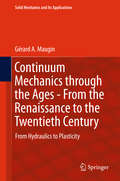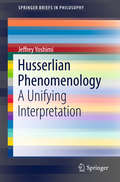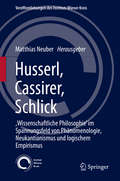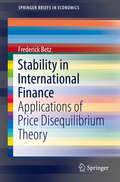- Table View
- List View
Participation in Computing: The National Science Foundation’s Expansionary Programs (History of Computing)
by William AsprayThis book provides a history of the efforts of the US National Science Foundation to broaden participation in computing. The book briefly discusses the early history of the NSF's involvement with education and workforce issues. It then turns to two programs outside the computing directorate (the ADVANCE program and the Program on Women and Girls) that set the stage for three programs in the NSF computing directorate on broadening participation: the IT Workforce Program, the Broadening Participation in Computing program, and the Computing Education for the 21st Century program. The work looks at NSF-funded research and NSF-funded interventions both to increase the number of women, underrepresented minorities (African Americans, Hispanics, and American Indians) and people with disabilities, and to increase the number of public schools offering rigorous instruction in computing. Other organizations such as the ACM, the Computer Science Teachers Association, and Code.org are also covered. The years covered are primarily 1980 to the present.
Under Red Skies: The Life and Times of a Chinese Millennial (PDF)
by Karoline KimKaroline Kan was born in 1989, the year of the Tiananmen Square massacre: her generation has always been caught between China's authoritarian politics and its hyper-modern technology and economic boom. In her quest to understand the shifting sands of global, connected China, Karoline turns to her family, who have survived Maoism and its legacy by breaking with tradition. Navigating a society beset by poverty and often violent political unrest, the Kans swapped rural villages for crowded city streets in search of a better way of life. Now a journalist, Kan recounts gripping tales of her grandmother, who struggled to help her family through the Great Famine; of her mother, who defied the One-Child Policy by giving birth to Karoline; and of her cousin, a factory worker scraping by on less than £1 per hour. An ambitious millennial pursuing her career and personal life in a time of dizzyingly rapid social change, Kan discovers her own story's roots in the China of previous generations.
A Companion to Eighteenth-Century Europe (Blackwell Companions to European History)
by Peter H. WilsonThis Companion contains 31 essays by leading international scholars to provide an overview of the key debates on eighteenth-century Europe. Examines the social, intellectual, economic, cultural, and political changes that took place throughout eighteenth-century Europe Focuses on Europe while placing it within its international context Considers not just major western European states, but also the often neglected countries of eastern and northern Europe
Mathematics and the Mind: An Introduction into Ibn Sīnā’s Theory of Knowledge (SpringerBriefs in Philosophy)
by Hassan TahiriThis book examines how epistemology was reinvented by Ibn Sīnā, an influential philosopher-scientist of the classical Islamic world who was known to the West by the Latinised name Avicenna. It explains his theory of knowledge in which intentionality acts as an interaction between the mind and the world. This, in turn, led Ibn Sīnā to distinguish an operation of intentionality specific to the generation of numbers.The author argues that Ibn Sīnā’s transformation of philosophy is one of the major stages in the de-hellinisation movement of the Greek heritage that was set off by the advent of the Arabic-Islamic civilisation. Readers first learn about Ibn Sīnā’s unprecedented investigation into the concept of the number and his criticism of such Greek thought as Plato’s realism, Pythagoreans’ empiricism, and Aristotle’s conception of existence. Next, coverage sets out the basics of Ibn Sīnā’s theory of knowledge needed for the construction of numbers. It describes how intentionality turns out to be key in showing the ontological dependence of numbers as well as even more critical to their construction. In describing the various mental operations that make mathematical objects intentional entities, Ibn Sīnā developed powerful arguments and subtle analyses to show us the extent our mental life depends on intentionality. This monograph thoroughly explores the epistemic dimension of this concept, which, the author believes, can also explain the actual genesis and evolution of mathematics by the human mind.
Historical Epistemology of Space: From Primate Cognition to Spacetime Physics (SpringerBriefs in History of Science and Technology #0)
by Matthias SchemmelThis monograph investigates the development of human spatial knowledge by analyzing its elementary structures and studying how it is further shaped by various societal conditions. By taking a thoroughly historical perspective on knowledge and integrating results from various disciplines, this work throws new light on long-standing problems in epistemology such as the relation between experience and preformed structures of cognition. What do the orientation of apes and the theory of relativity have to do with each other? Readers will learn how different forms of spatial thinking are related in a long-term history of knowledge. Scientific concepts of space such as Newton’s absolute space or Einstein’s curved spacetime are shown to be rooted in pre-scientific structures of knowledge, while at the same time enabling the integration of an ever expanding corpus of experiential knowledge. This work addresses all readers interested in questions of epistemology, in particular philosophers and historians of science. It integrates forms of spatial knowledge from disciplines including anthropology, developmental psychology and cognitive sciences, amongst others.
Contemporary American Cinema (UK Higher Education OUP Humanities & Social Sciences Media, Film & Cultural Studies)
by Linda Williams Michael Hammond“One of the rare collections I would recommend for use in undergraduate teaching – the chapters are lucid without being oversimplified and the contributors are adept at analyzing the key industrial, technological and ideological features of contemporary U.S. cinema.” Diane Negra, University of East Anglia, UK. “Contemporary American Cinema offers a fresh and sometimes revisionist look at developments in the American film industry from the 1960s to the present … Readers will find it lively and provocative.”Chuck Maland, University of Tennessee, USA. “Contemporary American Cinema is the book on the subject that undergraduate classes have been waiting for … Comprehensive, detailed, and intelligently organized [and] written in accessible and compelling prose … Contemporary American Cinema will be embraced by instructors and students alike.”Charlie Keil, Director, Cinema Studies Program, University of Toronto, Canada. “Contemporary American Cinema usefully gathers together a range of materials that provide a valuable resource for students and scholars. It is also a pleasure to read.” Hilary Radner, University of Otago, New Zealand. “Contemporary American Cinema deepens our knowledge of American cinema since the 1960s. … This is an important collection that will be widely used in university classrooms.”Lee Grieveson, University College London, UK. “Contemporary American Cinema is a clear-sighted and tremendously readable anthology, mapping the terrain of post-sixties US cinema with breadth and critical verve.” Paul Grainge, University of Nottingham, UK. “This collection of freshly written essays by leading specialists in the field will most likely be one of the most important works of reference for students and film scholars for years to come.”Liv Hausken, University of Oslo, Norway. Contemporary American Cinema is the first comprehensive introduction to American cinema since 1960. The book is unique in its treatment of both Hollywood, alternative and non-mainstream cinema. Critical essays from leading film scholars are supplemented by boxed profiles of key directors, producers and actors; key films and key genres; and statistics from the cinema industry. Illustrated in colour and black and white with film stills, posters and production images, the book has two tables of contents allowing students to use the book chronologically, decade-by-decade, or thematically by subject. Designed especially for courses in cinema studies and film studies, cultural studies and American studies, Contemporary American Cinema features a glossary of key terms, fully referenced resources and suggestions for further reading, questions for class discussion, and a comprehensive filmography. Individual chapters include:The decline of the studio systemThe rise of American new wave cinemaThe history of the blockbusterThe parallel histories of independent and underground filmBlack cinema from blaxploitation to the 1990sChanging audiencesThe effects of new technologyComprehensive overview of US documentary from 1960 to the presentContributors include: Stephen Prince, Steve Neale, Susan Jeffords,Yvonne Tasker, Barbara Klinger, Jim Hillier, Peter Kramer, Mark Shiel,Sheldon Hall, Eithne Quinn, Michele Aaron, Jonathan Munby.
Scientific Communication Across the Iron Curtain (SpringerBriefs in History of Science and Technology #0)
by Christopher D. HollingsThis monograph provides a concise introduction to the tangled issues of communication between Russian and Western scientists during the Cold War. It details the extent to which mid-twentieth-century researchers and practitioners were able to communicate with their counterparts on the opposite side of the Iron Curtain. Drawing upon evidence from a range of disciplines, a decade-by-decade account is first given of the varying levels of contact that existed via private correspondence and conference attendance. Next, the book examines the exchange of publications and the availability of one side's work in the libraries of the other. It then goes on to compare general language abilities on opposite sides of the Iron Curtain, with comments on efforts in the West to learn Russian and the systematic translation of Russian work. In the end, author Christopher Hollings argues that physical accessibility was generally good in both directions, but that Western scientists were afflicted by greater linguistic difficulties than their Soviet counterparts whose major problems were bureaucratic in nature. This volume will be of interest to historians of Cold War science, particularly those who study communications and language issues. In addition, it will be an ideal starting pointing for anyone looking to know more about this fascinating area.
My Search for Ramanujan: How I Learned to Count
by Ken Ono Amir D. Aczel"The son of a prominent Japanese mathematician who came to the United States after World War II, Ken Ono was raised on a diet of high expectations and little praise. Rebelling against his pressure-cooker of a life, Ken determined to drop out of high school to follow his own path. To obtain his father’s approval, he invoked the biography of the famous Indian mathematical prodigy Srinivasa Ramanujan, whom his father revered, who had twice flunked out of college because of his single-minded devotion to mathematics.Ono describes his rocky path through college and graduate school, interweaving Ramanujan’s story with his own and telling how at key moments, he was inspired by Ramanujan and guided by mentors who encouraged him to pursue his interest in exploring Ramanujan’s mathematical legacy.Picking up where others left off, beginning with the great English mathematician G.H. Hardy, who brought Ramanujan to Cambridge in 1914, Ono has devoted his mathematical career to understanding how in his short life, Ramanujan was able to discover so many deep mathematical truths, which Ramanujan believed had been sent to him as visions from a Hindu goddess. And it was Ramanujan who was ultimately the source of reconciliation between Ono and his parents.Ono’s search for Ramanujan ranges over three continents and crosses paths with mathematicians whose lives span the globe and the entire twentieth century and beyond. Along the way, Ken made many fascinating discoveries. The most important and surprising one of all was his own humanity."
The Surgions Mate: The First Compendium on Naval Medicine, Surgery and Drug Therapy (London 1617). Edited and Annotated by Irmgard Müller (Classic Texts in the Sciences)
by John WoodallThis book reproduces and comments John Woodall’s handbook which was used as standard text for medical treatment at sea in the seventeenth century and was the first instruction for medical service aboard on the whole. In 1612 the East India Company, founded in London 1600 and invested with special royal privileges and authority, appointed John Woodall as its first surgeon-general, who had gained great medical experience at theatres of war abroad. Woodall was appointed the task to radically reform the medical aid on sailing ships and to supervise the education of talented ship doctors. He was the first one to establish standardized regulations concerning the provision of instruments and medicaments on board. To this end he wrote an instructive manual for ship surgeons with the title “The Surgions Mate”, published in 1617 in London and edited repeatedly until 1655, listing essential instruments and remedies for the use at sea and providing detailed annotations. The manual’s particularities include notes on the portion of paracelsian drugs, the first enema of tobacco, the treatment of gunshot wounds and the strong recommendation of lemon juice against scurvy. Moreover, descriptions of injuries, instruments, and many diseases as a result of Woodall’s extended personal observations at sea are given. The present edition of this exceptional classic includes comprehensive annotations on the first medical chest and its application on sailing ships. Also, the implications of Woodall’s achievements in regard to the development of ship medicine and pharmacy in other seafaring nations are discussed. The book will appeal to historians of medicine and interested readers alike.
Religion and Culture in Dialogue: East and West Perspectives (Sophia Studies in Cross-cultural Philosophy of Traditions and Cultures #15)
by Jānis Tālivaldis OzoliņšThis volume addresses the issue of the human encounter with the Mystery of God and the purpose of human life. It explores major themes from diverse cultural and philosophical traditions, starting with questions about the possibility of belief in God, His transcendence as seen in both East and West, and ending with questions about ethics and about personhood, human dignity and human rights. Taking an eclectic approach, the chapters in this book each uniquely address aspects of the human encounter with the Mystery of God, drawing from specific cultures and traditions, and using a particular philosophical and theological style. Together, the chapters provide a fresh approach and a synergy that ensures that each topic contributes something new to the dialogue between religion and culture.
Modernisation of the Criminal Justice Chain and the Judicial System: New Insights on Trust, Cooperation and Human Capital (Ius Gentium: Comparative Perspectives on Law and Justice #50)
by Annie Hondeghem Xavier Rousseaux Fréderic SchoenaersThis book focuses on one part of the judicial system: the criminal justice chain. This involves all the activities and actors dealing with policing, prosecution, judgment, and sanctioning of crimes. In the last decades, reforms have been implemented in several European countries. In Belgium, for example, there was the so-called Octopus reform in 1998. The police was restructured, leading to an integration of the police forces on a national and local level. New steering instruments were introduced, such as regional security plans. With regard to the sanctioning of crimes, a new institution was installed, called the sentence implementation court. This book evaluates these reforms and discusses the current reform on the reorganization of the judicial landscape. In addition, it examines the relation between trust and distrust and the application to the judicial system. It discusses the human capital aspect of the system, by means of a study on the prosopography of the Belgian magistrates that analyses the Magistracy as socio-professional group, and focuses on situations of system building, transformations under constraint (occupations), and transfers (colonial experience). Lastly, the book presents a comparative study of Belgium and France regarding the new techniques and instruments that are needed to accelerate the judicial response time and to ensure that the judicial system delivers its services on time.
A Mathematician's Journeys: Otto Neugebauer and Modern Transformations of Ancient Science (Archimedes #45)
by Alexander Jones Christine Proust John M. SteeleThis book explores facets of Otto Neugebauer's career, his impact on the history and practice of mathematics, and the ways in which his legacy has been preserved or transformed in recent decades, looking ahead to the directions in which the study of the history of science will head in the twenty-first century. Neugebauer, more than any other scholar of recent times, shaped the way we perceive premodern science. Through his scholarship and influence on students and collaborators, he inculcated both an approach to historical research on ancient and medieval mathematics and astronomy through precise mathematical and philological study of texts, and a vision of these sciences as systems of knowledge and method that spread outward from the ancient Near Eastern civilizations, crossing cultural boundaries and circulating over a tremendous geographical expanse of the Old World from the Atlantic to India.
The Aristotelian Mechanics: Text and Diagrams (Boston Studies in the Philosophy and History of Science #316)
by Joyce van LeeuwenThis book examines the transmission processes of the Aristotelian Mechanics. It does so to enable readers to appreciate the value of the treatise based on solid knowledge of the principles of the text. In addition, the book’s critical examination helps clear up many of the current misunderstandings about the transmission of the text and the diagrams. The first part of the book sets out the Greek manuscript tradition of the Mechanics, resulting in a newly established stemma codicum that illustrates the affiliations of the manuscripts. This research has led to new insights into the transmission of the treatise, most importantly, it also demonstrates an urgent need for a new text. A first critical edition of the diagrams contained in the Greek manuscripts of the treatise is also presented. These diagrams are not only significant for a reconstruction of the text but can also be considered as a commentary on the text. Diagrams are thus revealed to be a powerful tool in studying processes of the transfer and transformation of knowledge. This becomes especially relevant when the manuscript diagrams are compared with those in the printed editions and in commentaries from the early modern period. The final part of the book shows that these early modern diagrams and images reflect the altered scope of the mechanical discipline in the sixteenth century.
On the Hypotheses Which Lie at the Bases of Geometry (Classic Texts in the Sciences #0)
by Bernhard RiemannThis book presents William Clifford’s English translation of Bernhard Riemann’s classic text together with detailed mathematical, historical and philosophical commentary. The basic concepts and ideas, as well as their mathematical background, are provided, putting Riemann’s reasoning into the more general and systematic perspective achieved by later mathematicians and physicists (including Helmholtz, Ricci, Weyl, and Einstein) on the basis of his seminal ideas. Following a historical introduction that positions Riemann’s work in the context of his times, the history of the concept of space in philosophy, physics and mathematics is systematically presented. A subsequent chapter on the reception and influence of the text accompanies the reader from Riemann’s times to contemporary research. Not only mathematicians and historians of the mathematical sciences, but also readers from other disciplines or those with an interest in physics or philosophy will find this work both appealing and insightful.
The Unforgotten Sisters: Female Astronomers and Scientists before Caroline Herschel (Springer Praxis Books)
by Gabriella BernardiTaking inspiration from Siv Cedering’s poem in the form of a fictional letter from Caroline Herschel that refers to “my long, lost sisters, forgotten in the books that record our science”, this book tells the lives of twenty-five female scientists, with specific attention to astronomers and mathematicians. Each of the presented biographies is organized as a kind of "personal file" which sets the biographee’s life in its historical context, documents her main works, highlights some curious facts, and records citations about her. The selected figures are among the most representative of this neglected world, including such luminaries as Hypatia of Alexandra, Hildegard of Bingen, Elisabetha Hevelius, and Maria Gaetana Agnesi. They span a period of about 4000 years, from En HeduAnna, the Akkadian princess, who was one of the first recognized female astronomers, to the dawn of the era of modern astronomy with Caroline Herschel and Mary Somerville. The book will be of interest to all who wish to learn more about the women from antiquity to the nineteenth century who played such key roles in the history of astronomy and science despite living and working in largely male-dominated worlds.
Chemistry Education and Contributions from History and Philosophy of Science (Science: Philosophy, History and Education)
by Mansoor NiazThis book explores the relationship between the content of chemistry education and the history and philosophy of science (HPS) framework that underlies such education. It discusses the need to present an image that reflects how chemistry developed and progresses. It proposes that chemistry should be taught the way it is practiced by chemists: as a human enterprise, at the interface of scientific practice and HPS. Finally, it sets out to convince teachers to go beyond the traditional classroom practice and explore new teaching strategies. The importance of HPS has been recognized for the science curriculum since the middle of the 20th century. The need for teaching chemistry within a historical context is not difficult to understand as HPS is not far below the surface in any science classroom. A review of the literature shows that the traditional chemistry classroom, curricula, and textbooks while dealing with concepts such as law, theory, model, explanation, hypothesis, observation, evidence and idealization, generally ignore elements of the history and philosophy of science. This book proposes that the conceptual understanding of chemistry requires knowledge and understanding of the history and philosophy of science.“Professor Niaz’s book is most welcome, coming at a time when there is an urgently felt need to upgrade the teaching of science. The book is a huge aid for adding to the usual way - presenting science as a series of mere facts - also the necessary mandate: to show how science is done, and how science, through its history and philosophy, is part of the cultural development of humanity.”Gerald Holton, Mallinckrodt Professor of Physics & Professor of History of Science, Harvard University“In this stimulating and sophisticated blend of history of chemistry, philosophy of science, and science pedagogy, Professor Mansoor Niaz has succeeded in offering a promising new approach to the teaching of fundamental ideas in chemistry. Historians and philosophers of chemistry --- and above all, chemistry teachers --- will find this book full of valuable and highly usable new ideas”Alan Rocke, Case Western Reserve University “This book artfully connects chemistry and chemistry education to the human context in which chemical science is practiced and the historical and philosophical background that illuminates that practice. Mansoor Niaz deftly weaves together historical episodes in the quest for scientific knowledge with the psychology of learning and philosophical reflections on the nature of scientific knowledge and method. The result is a compelling case for historically and philosophically informed science education. Highly recommended!”Harvey Siegel, University of Miami “Books that analyze the philosophy and history of science in Chemistry are quite rare. ‘Chemistry Education and Contributions from History and Philosophy of Science’ by Mansoor Niaz is one of the rare books on the history and philosophy of chemistry and their importance in teaching this science. The book goes through all the main concepts of chemistry, and analyzes the historical and philosophical developments as well as their reflections in textbooks.Closest to my heart is Chapter 6, which is devoted to the chemical bond, the glue that holds together all matter in our earth. The chapter emphasizes the revolutionary impact of the concept of the ‘covalent bond’ on the chemical community and the great novelty of the idea that was conceived 11 years before quantum mechanics was able to offer the mechanism of electron pairing and covalent bonding. The author goes then to describe the emergence of two rival theories that explained the nature of the chemical bond in terms of quantum mechanics; these are valence bond (VB) and molecular orbital (MO) theories. He emphasizes the importance of having rival theories and interpretations in science and its advancement. He further argues that this VB-MO rivalry is still alive and together the two conceptual frames serve as the tool kit for thinking and doing chemistry in creative manners. The author surveys chemistr
The Credibility of Sovereignty – The Political Fiction of a Concept
by Elia R.G. PusterlaThe book deeply analyses the bilateral relations between Switzerland and the European Union and their effect on the former's sovereignty in the context of Europeanisation. This touches on philosophical debates on the complexity of sovereignty. What sovereignty is at stake when talking about Swiss-EU relations? This issue not only faces the elusiveness of sovereignty as a concept, but also the proliferation of hypocrisy on its presence within states. The book encounters the deconstructionist hypothesis stating that there is nothing to worry about but the belief there is something to worry about. Derrida’s deconstruction of sovereignty allows indeed one to grasp the fictional essence of sovereignty based on the metaphysics of presence. The presence of self-positing sovereign ipseity is fictional since absent in the present, but spectrally present in the belief of its presence to come. Sovereignty is a matter of credibility, or the credible promise of a normative statement to come. Hence, the book challenges the realist/neorealist argument stating that states are credibly sovereign until proven otherwise and explains that the debate on state sovereignty calls for the unveiling of this hypocritical epistemology cunningly disguised as an objective presence. Swiss-EU relations thus become the cornerstone to not only theorise but also test sovereignty and deconstruct the two ontological and epistemological sides of the same coin, or the modern hypocrisy of sovereignty. This deconstruction constitutes the very problématique of any attempt to understand whether and how a state can be sovereign and solve the problem as to how to neutralise the différance and identify the difference between credible and incredible claims of sovereignty. This problématique connects the theory and practice of sovereignty innovatively, providing positivist evidence on the arguable credibility of the Swiss claim of sovereignty and confirming the presence of a theological dimension within politics.
The Search for Human Chromosomes: A History of Discovery
by Wilson John WallThis book is a broadly historical account of a remarkable and very exciting scientific story–the search for the number of human chromosomes. It covers the processes and people, culminating in the realization that discovering the number of human chromosomes brought as much benefit as unraveling the genetic code itself. With the exception of red blood cells, which have no nucleus and therefore no DNA, and sex cells, humans have 46 chromosomes in every single cell. Not only do chromosomes carry all of the genes that code our inheritance, they also carry them in a specific order. It is essential that the number and structure of chromosomes remains intact, in order to pass on the correct amount of DNA to succeeding generations and for the cells to survive. Knowing the number of human chromosomes has provided a vital diagnostic tool in the prenatal diagnosis of genetic disorders, and the search for this number and developing an understanding of what it means are the focus of this book.
Gardens, Knowledge and the Sciences in the Early Modern Period (Trends in the History of Science)
by Hubertus Fischer Volker R. Remmert Joachim Wolschke-BulmahnThis volume focuses on the outstanding contributions made by botany and the mathematical sciences to the genesis and development of early modern garden art and garden culture. The many facets of the mathematical sciences and botany point to the increasingly “scientific” approach that was being adopted in and applied to garden art and garden culture in the early modern period. This development was deeply embedded in the philosophical, religious, political, cultural and social contexts, running parallel to the beginning of processes of scientization so characteristic for modern European history. This volume strikingly shows how these various developments are intertwined in gardens for various purposes.
Rethinking Documentary: New Perspectives And Practices (UK Higher Education OUP Humanities & Social Sciences Media, Film & Cultural Studies)
by Thomas Austin Wilma De JongFrom a boom in theatrical features to footage posted on websites such as YouTube and Google Video, the early years of the 21st century have witnessed significant changes in the technological, commercial, aesthetic, political, and social dimensions of documentaries on film, television and the web. In response to these rapid developments, this book rethinks the notion of documentary, in terms of theory, practice and object/s of study. Drawing together 26 original essays from scholars and practitioners, it critically assesses ideas and constructions of documentary and, where necessary, proposes new tools and arguments with which to examine this complex and shifting terrain. Covering a range of media output, the book is divided into four sections: Critical perspectives on documentary forms and concepts The changing faces of documentary productionContemporary documentary: borders, neighbours and disputed territories Digital and online documentaries: opportunities and limitations Rethinking Documentary is valuable reading for scholars and students working in documentary theory and practice, film studies, and media studies.
Continuum Mechanics through the Ages - From the Renaissance to the Twentieth Century: From Hydraulics to Plasticity (Solid Mechanics and Its Applications #223)
by Gérard A. MauginMixing scientific, historic and socio-economic vision, this unique book complements two previously published volumes on the history of continuum mechanics from this distinguished author. In this volume, Gérard A. Maugin looks at the period from the renaissance to the twentieth century and he includes an appraisal of the ever enduring competition between molecular and continuum modelling views. Chapters trace early works in hydraulics and fluid mechanics not covered in the other volumes and the author investigates experimental approaches, essentially before the introduction of a true concept of stress tensor. The treatment of such topics as the viscoelasticity of solids and plasticity, fracture theory, and the role of geometry as a cornerstone of the field, are all explored. Readers will find a kind of socio-historical appraisal of the seminal contributions by our direct masters in the second half of the twentieth century. The analysis of the teaching and research texts by Duhem, Poincaré and Hilbert on continuum mechanics is key: these provide the most valuable documentary basis on which a revival of continuum mechanics and its formalization were offered in the late twentieth century. Altogether, the three volumes offer a generous conspectus of the developments of continuum mechanics between the sixteenth century and the dawn of the twenty-first century. Mechanical engineers, applied mathematicians and physicists alike will all be interested in this work which appeals to all curious scientists for whom continuum mechanics as a vividly evolving science still has its own mysteries.
Husserlian Phenomenology: A Unifying Interpretation (SpringerBriefs in Philosophy)
by Jeffrey YoshimiThis book unifies a large part of the vast body of Husserlian phenomenology using a relatively simple set of dynamical laws. The underlying idea of the book is that a certain core theory of “world-constitution” in Husserl can be formalized and presented in less than 100 pages, with the aid of detailed graphics and quantitative textual analysis. The book is the first to formalize so much of Husserl’s work in such a short space. It is both a contribution to Husserl scholarship, and a unique and accessible introduction to Husserlian phenomenology. By making key Husserlian ideas clear and by formally expressing them, it facilitates efforts to apply Husserlian phenomenology in various domains, in particular to cognitive science. The book thus prepares the way for a detailed point-by-point set of connections between Husserl’s phenomenology and contemporary cognitive science.
Husserl, Cassirer, Schlick: ,Wissenschaftliche Philosophie’ im Spannungsfeld von Phänomenologie, Neukantianismus und logischem Empirismus (Veröffentlichungen des Instituts Wiener Kreis #23)
by Matthias NeuberPhänomenologie, Neukantianismus und logischer Empirismus waren die dominanten Strömungen in der deutschsprachigen theoretischen Philosophie des frühen 20. Jahrhunderts. Die Beziehungen dieser drei philosophischen Positionen untereinander wurden in der philosophiehistorischen Forschung bisher allenfalls in Teilkonstellationen untersucht. Der Band liefert erstmals eine Zusammenschau dieser drei Positionen. Die Autoren gehen in ihren Aufsätzen der Frage auf den Grund, wie die Beziehungen zueinander zu bestimmen sind und zwar unter dem Gesichtspunkt der wissenschaftlichen Philosophie, dem Projekt, das alle drei Protagonisten – Edmund Husserl, Ernst Cassirer und Moritz Schlick – verfolgten und dabei jeweils eine eigene Version entwickelten. Die Aufsätze sind in drei Blöcken zusammengefasst. Der erste Block widmet sich Edmund Husserls Phänomenologie, der zweite Ernst Cassirers Neukantianismus und der dritte dem logischem Empirismus von Moritz Schlick. In ihren Beiträgen stellen die Autoren immer wieder Bezüge zu den jeweils anderen Protagonisten und ihren für die Fragestellung maßgeblichen Schriften her. Der Band richtet sich an Forscher und Studierende, die sich mit der Geschichte der Wissenschaftsphilosophie befassen und die Struktur des Diskurses in der ‚kontinentalen‘ Philosophie des frühen 20. Jahrhunderts nachvollziehen möchten.
Stability in International Finance: Applications of Price Disequilibrium Theory (SpringerBriefs in Economics #0)
by Frederick BetzThis book aims to explore stability in an international financial system using disequilibrium theory. It examines historical cases of both instability and stability and reviews price-disequilibrium theory to construct a theoretical model for a stable international financial system. In the modern knowledge economy in a global world, financial socio-technical systems still continue to be central to global commerce. Moreover, technological advances in computer and communications have changed both the knowledge economy and the financial system. While globalization and technology have made international finance more powerful and important to knowledge economies, they have also increased the volatility, instability, and fraudulent use of international finance. The international world has not experienced a long-term, stable financial system after 1913. International financial systems have been periodically unstable, triggering financial crises and resultant economic depressions in different nations. Yet the global economy cannot develop properly without a stable international system, which distributes wealth to economically productive activities. How then can a stable and modern international-financial-system be constructed? In this provocative volume, the authors applies the cross-disciplinary analysis of societal dynamics to important economic writers to derive a new approach to the problem of stabilizing international financial systems.
Cinema Entertainment: Essays On Audiences, Films And Film Makers (UK Higher Education OUP Humanities & Social Sciences Media, Film & Cultural Studies)
by Gianluca Sergi Alan LovellEntertainment is a defining feature of contemporary culture, yet it is often accused of being superficial and even harmful. In this thought-provoking book, the authors challenge this negative view and argue for a reconsideration of the value of entertainment and the effect it has on the world in which we live. Taking Hollywood cinema as its central focus, this exciting book explores the range of debates that the phenomenon of cinema entertainment has aroused. It is packed with examples from modern, popular films throughout, including a whole chapter on the hugely successful film The Dark Knight. The book features interviews with Randy Thom and Walter Murch, filmmakers involved in creating some of the most successful films of recent years. There is an interesting discussion of the work and reputation of renowned filmmakers, Steven Spielberg and Alfred Hitchcock, names which have become synonymous with cinema entertainment. The authors consider what makes a film successful by looking at box office figures as well as detailed description and critique of current debates surrounding what it means to entertain and be entertained.Cinema Entertainment is important reading for film and media students as well as anyone interested in contemporary mass culture.
